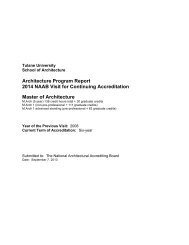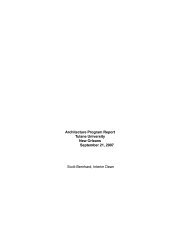NAAB Conditions for Accreditation, 2009 - Tulane School of ...
NAAB Conditions for Accreditation, 2009 - Tulane School of ...
NAAB Conditions for Accreditation, 2009 - Tulane School of ...
You also want an ePaper? Increase the reach of your titles
YUMPU automatically turns print PDFs into web optimized ePapers that Google loves.
<strong>2009</strong> <strong>Conditions</strong> <strong>for</strong> <strong>Accreditation</strong><br />
National Architectural Accrediting Board, Inc.<br />
Appendix 6: Background and History <strong>of</strong> the National Architectural Accrediting Board<br />
History <strong>of</strong> <strong>Accreditation</strong> in Architecture Education<br />
The first step leading to architectural accreditation was taken in Illinois where the first<br />
legislation regulating the practice <strong>of</strong> architecture was enacted in 1897. Following that<br />
enactment, in 1898 the Illinois Board <strong>of</strong> Examiners and Regulators <strong>of</strong> Architects gave its<br />
first examination. By 1902 they had established a rule restricting the examination to<br />
graduates <strong>of</strong> the state’s approved 4-year architecture curriculum. In 1903, the board<br />
expanded this policy to include graduates from Cornell, Columbia, and Harvard<br />
Universities, the Massachusetts Institute <strong>of</strong> Technology, and the University <strong>of</strong><br />
Pennsylvania. That action demonstrated the need <strong>for</strong> national standards <strong>of</strong> architectural<br />
education.<br />
The first attempt to establish national standards came with the founding <strong>of</strong> the Association<br />
<strong>of</strong> Collegiate <strong>School</strong>s <strong>of</strong> Architecture (ACSA) in 1912 and its adoption two years later <strong>of</strong><br />
“standard minima,” which schools were required to meet to gain ACSA membership. While<br />
these standard minima were in place, ACSA membership was equivalent to accreditation.<br />
In 1932, the ACSA abandoned the standard minima, causing an 8-year hiatus in the<br />
pr<strong>of</strong>ession’s national system <strong>of</strong> pr<strong>of</strong>essional architecture education – a hiatus brought to an<br />
end when the ACSA, The American Institute <strong>of</strong> Architects (AIA), and National Council <strong>of</strong><br />
Architectural Registration Boards (NCARB) established the <strong>NAAB</strong> and gave it authority to<br />
accredit schools <strong>of</strong> architecture nationally. The founding agreement <strong>of</strong> 1940 also<br />
announced the intention to create an integrated system <strong>of</strong> architectural education that<br />
would allow schools with varying resources and circumstances to develop according to<br />
their particular needs.<br />
In 1972, the membership <strong>of</strong> the <strong>NAAB</strong> Board <strong>of</strong> Directors was expanded to include one<br />
student representative nominated by “the Association <strong>of</strong> Student Chapters/ AIA 13 ” and one<br />
graduate student nominated by schools accredited by the <strong>NAAB</strong>. In 1999, this<br />
representation was further refined to be two individuals nominated by the American<br />
Institute <strong>of</strong> Architecture Students.<br />
The foundation <strong>for</strong> the system, or model, <strong>for</strong> accreditation in architecture education that<br />
many know today was first outlined in an inter-collateral report, The Restructuring <strong>of</strong> the<br />
<strong>NAAB</strong>, which was completed in 1975. In that report, the collateral organizations identified<br />
two over-arching goals <strong>for</strong> the <strong>NAAB</strong>:<br />
Advancement <strong>of</strong> all phases <strong>of</strong> architectural education, with a view toward the<br />
promotion <strong>of</strong> public welfare.<br />
Provide guidance, encourage improvement and innovation in the architecture system<br />
process, program experience, and product with a view toward serving the public<br />
interest and meeting societal needs.<br />
And three objectives <strong>for</strong> the accreditation process:<br />
To hold a school accountable to its own stated objectives to the student, the<br />
pr<strong>of</strong>ession, the institution, and the public community.<br />
13 The Association <strong>of</strong> Students Chapters/AIA was later renamed The American Institute <strong>of</strong><br />
Architecture Students (AIAS).<br />
41














